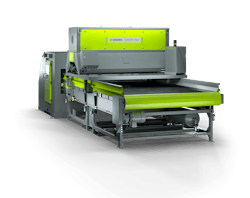By Ron Shinn
Sesotec GmbH has expanded its Varisort line of plastic sorting equipment with the Varisort+ Flex, designed specifically to detect and separate different types of plastics, colors, shapes, metals and other foreign objects from various material streams. The German company said throughput is up to 8 tons per hour, with a reject reliability rate of up to 99 percent.
Sesotec said the Flex is aimed at the increasing number of waste streams with fluctuating quality.
The Flex line relies on up to three of Sesotec’s wide range of sensors that detect color, metal and polymer types. Sesotec has been an early proponent of using artificial intelligence to improve sensor technology and sorting capabilities to enable sorting of previously indistinguishable materials.
A complete system includes the array of sensors and lights placed above a high-speed conveyor belt, a blow-out system with compressed-air nozzles for separating foreign bodies, and housing for rejections. If it is included, a metal sensor is located beneath the conveyor belt.
The three different types of sensors can be mixed based on the user’s requirements.
Combinations such as only color sensors, color plus near infrared (NIR), color plus metal, color plus metal plus NIR, only NIR or metal plus NIR are possible.
A high-resolution color scan camera with multiple lighting options is capable of detecting up to 17 million colors, according to Sesotec. The color sensor also separates by colors plus shapes.
An inductive metal sensor identifies and detects magnetic and non-magnetic metals down to 1mm in size. It can also identify stainless steel. Metal sensitivity settings are adjustable.
An NIR hyperspectral camera identifies different polymers. Sesotec said it can detect PET trays and bottles with labels, recognize different material types such as HDPE and LDPE and detect mono- and multilayer material.
In addition to the sensor capabilities, the Flex unit is available in different working widths and can be used with a plant’s current conveyor system or a Sesotec-provided conveyor. Sesotec said sensors can be retrofitted, and the Flex requires very little maintenance and has a high equipment availability rating.
Four models are available, with throughputs of 3 tons per hour, 4.5 tons per hour, 6 tons per hour and 8 tons per hour.
The smallest model with 3 tons per hour throughput has a working width of 40.3 inches, and the number of compressed air valves is 64/40.
The model with a throughput of 4.5 tons per hour has a working width of 60.5 inches and 96/60 valves.
The model with a throughput of 6 tons per hour has a working width of 75.6 inches and 120/75 valves.
With 8 tons per hour throughput, the largest model has a working width of 110.9 inches and 160/110 valves.
All four sizes have a suitable grain size of 15mm to 350mm.
An available option is division of the sorter for parallel sorting of two different material
streams or for two-stage sorting.
The standard valve pitches of 16mm and 25.6mm, or 17.6mm and 25.6mm for the largest model, can be adjusted for specific applications.
The Flex uses Sesotec’s Visudesk visualization software that allows operators to use a touch-display control panel to set target points for sorting.
In addition to the Varisort+ Flex, Sesotec also sells the Varisort+ system for plastics recycling.
Contact:
Sesotec Inc., Bartlett Ill., 224-208-1900, www.sesotec.com
About the Author
Ron Shinn
Editor
Editor Ron Shinn is a co-founder of Plastics Machinery & Manufacturing and has been covering the plastics industry for more than 35 years. He leads the editorial team, directs coverage and sets the editorial calendar. He also writes features, including the Talking Points column and On the Factory Floor, and covers recycling and sustainability for PMM and Plastics Recycling.
